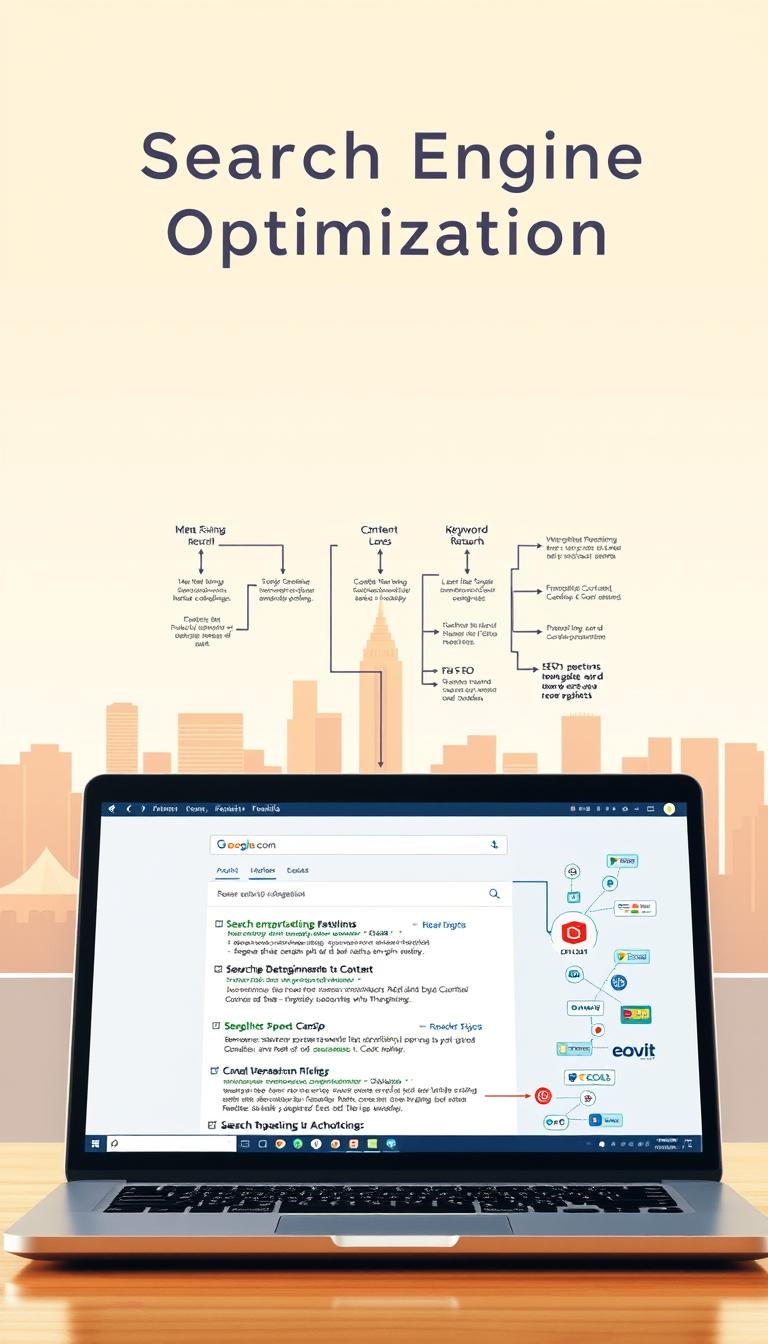
As we explore the changing world of digital marketing, becoming an SEO expert in 2025 is more than just knowing keywords and backlinks.
Search engine optimization is changing fast with AI, machine learning, and new ranking algorithms. It’s key for beginners to learn the basics.
We’ll cover what SEO is, why it matters, and the basics for beginners starting their SEO journey.
Key Takeaways
- Knowing the basics of search engine optimization is vital for a strong online presence.
- SEO uses technical, on-page, and off-page strategies to boost rankings and organic traffic.
- Mastering SEO basics is the first step to becoming an SEO expert.
- Keeping up with AI, machine learning, and ranking algorithm updates is crucial.
- A well-thought-out SEO strategy can greatly enhance your online visibility.
Understanding the Basics of SEO
Starting our SEO journey means first learning the basics. SEO, or search engine optimization, helps websites show up better in search results. By making our site better for search engines, we get more visitors and make more money.
What is SEO and Why is It Important?
SEO is vital for businesses because it brings in the right kind of visitors. Knowing how search engines work and what people look for helps us create better content. This makes our site more visible and improves how users feel when they visit.
For example, when we search online, we use specific words or phrases. SEO helps our website rank higher in search results for those words. This means more people are likely to visit our site.
| SEO Benefit | Description |
|---|---|
| Increased Visibility | Higher rankings in search engine results |
| Targeted Traffic | Attracting relevant audience to the website |
| Improved User Experience | Optimizing content to meet user needs |
Common SEO Terminology We Should Know
Knowing basic SEO terms is key for talking and planning strategies. Let’s look at some important ones:
- Keyword: A word or phrase that describes a webpage’s content.
- Meta Tags: Small text summaries of a webpage’s content.
- Backlink: A link from one site to another, seen as a vote of confidence.
How Search Engines Work
Understanding search engine optimization basics starts with knowing how search engines work. They use a three-step process: crawling, indexing, and ranking. This is key to seeing a website on the web.
To get how search engines work, we must look into their details. We need to grasp the algorithms that run them.
The Role of Algorithms
Algorithms are crucial in ranking websites. They look at relevance, quality, and user experience. This helps decide the order of websites in search results.
Search engine algorithms change often to better match search results. Keeping up with SEO techniques is vital for staying ahead.

Crawling and Indexing Explained
Crawling and indexing are vital steps for search engines. Crawling finds new and updated web content. Indexing stores and organizes this content in huge databases.
For a website to show up in search results, it must be crawled and indexed. This shows why making a website crawlable and indexable is so important.
- Crawling lets search engines find new content.
- Indexing helps search engines store and find content.
- Good optimization makes sure content is both crawlable and indexable.
Keyword Research: Finding the Right Terms
Keyword research is key to a successful SEO campaign. It helps businesses find their target audience. By using the right keywords, we can boost our online presence and attract more relevant visitors.
Keyword research isn’t just about finding popular terms. It’s about finding the exact phrases our potential customers use. This lets us create content that meets their needs perfectly.
Tools for Effective Keyword Research
Many tools can help with keyword research. Google Keyword Planner, Ahrefs, SEMrush, and Moz Keyword Explorer are some of the most popular. They give insights into search volume, competition, and related keywords, helping us improve our strategy.
Google Keyword Planner is good for beginners, offering a wide range of keyword ideas. Ahrefs and SEMrush, however, have more advanced features. They include competitor analysis and keyword difficulty scores, which are great for refining our SEO.

⭐️ Tap the exclusive deal link https://temu.to/k/uot8tcxvwum to score top-quality items at ultra-low prices. 🛍️ These unbeatable deals are only available here. Shop now and save big! ⭐️ Directly get exclusive deal in Temu app here: https://app.temu.com/m/mhb5rstagbx
Another surprise for you! Click https://temu.to/k/uag0bn0o0wd to earn with me together🤝!
Short-Tail vs. Long-Tail Keywords
It’s important to know the difference between short-tail and long-tail keywords. Short-tail keywords are short and general (e.g., “SEO tips”). Long-tail keywords are more specific and less competitive (e.g., “SEO tips for beginners”).
Long-tail keywords have lower search volumes but are less competitive. They are more targeted to specific searches. Using long-tail keywords can be a smart strategy for beginners, as it helps us reach niche audiences with less competition.
In summary, effective keyword research involves using the right tools to find both short-tail and long-tail keywords. By doing this, we can create content that’s more likely to be found by those searching for what we offer.
On-Page SEO Techniques
Learning and using on-page SEO techniques can really help your website rank better. On-page SEO makes your website more friendly to search engines. This improves how visible and relevant it is.
Optimizing Meta Tags and Descriptions
Meta tags and descriptions are key for SEO. They give search engines info about your webpage’s content. Optimizing meta tags, like title tags and meta descriptions, helps search engines get your page’s context and relevance.
A good title tag should be short, clear, and have your main keyword. A great meta description can make more people click on your page by being interesting.
| Meta Tag | Description | Best Practice |
|---|---|---|
| Title Tag | Defines the title of a webpage | Include primary keyword, be descriptive and concise |
| Meta Description | Provides a summary of the webpage | Entice users to click, include relevant keywords |
The Importance of Content Quality
Quality content is the heart of good SEO. Search engines love content that is engaging, informative, and relevant to what users are searching for. Create content that meets your audience’s needs and concerns.
Using LSI keywords makes your content richer and easier for search engines to understand. Also, updating your content regularly shows search engines that your site is active and should be crawled more often.
Using Headings and Subheadings Effectively
Headings and subheadings are crucial for organizing your content. They help both users and search engines find their way around. Proper use of H1, H2, H3, etc., tags can greatly improve your content’s readability and SEO.
- Use H1 tags for the main title
- Utilize H2 and H3 tags for subheadings and sub-subheadings
- Ensure headings are descriptive and include relevant keywords

Off-Page SEO Strategies
Let’s explore off-page SEO techniques to boost our website’s authority. These strategies are key to making our site more visible and ranked higher. They tell search engines our site is trustworthy and relevant.
Building Quality Backlinks
Getting high-quality backlinks is vital for off-page SEO. It boosts our domain authority and rankings. We should aim for backlinks from sites that are authoritative and match our niche.
The process includes guest blogging, making shareable content, and using our connections with other reputable sites. Quality is more important than quantity when it comes to backlinks.
| Backlink Type | Description | Impact on SEO |
|---|---|---|
| Guest Blogging | Writing articles for other reputable sites | High |
| Shareable Content | Creating content that others want to link to | High |
| Directory Listings | Listing our site in relevant directories | Moderate |
Engaging on Social Media to Boost SEO
Being active on social media can greatly help our SEO. It makes our brand more visible and brings more traffic to our site. Sharing our content on social media helps us reach more people and get more links.
Consistency is key in social media. Posting regularly and interacting with our audience boosts our online presence.

By using these off-page SEO strategies, we can make our website more authoritative and visible. As we learn more about SEO, remember that off-page SEO takes time and effort. It’s a long-term strategy that needs patience and persistence.
Technical SEO Essentials
Technical SEO is key to a good search engine optimization strategy. It makes sure search engines can easily find and list our site. It’s about building a strong base that helps both search engines and users.
Improving Website Speed and Performance
Website speed is very important because it affects how users feel about our site. A slow site can make people leave quickly and not engage much.
To make our site faster, we can work on images, use browser caching, and make CSS and JavaScript files smaller.
Key Strategies for Enhancing Website Speed:
- Optimize images to reduce file size without losing quality.
- Enable browser caching to store often-used resources locally.
- Minify and compress files like CSS, JavaScript, and HTML.
Mobile Optimization: Why It Matters
Most searches now come from mobile devices. So, making sure our site works well on phones is crucial.
Mobile optimization means making our site responsive, fast, and easy to use on small screens.
Benefits of Mobile Optimization:
| Benefit | Description |
|---|---|
| Improved User Experience | Mobile-friendly sites are easier to navigate and read on smaller screens. |
| Higher Search Engine Rankings | Google favors mobile-friendly websites in its search results. |
| Increased Conversions | A smooth mobile experience can boost conversion rates. |
Utilizing XML Sitemaps
An XML sitemap lists our website’s URLs, helping search engines find and crawl our content better.
By sending a sitemap to Google Search Console, we make sure our pages get indexed fast.

By focusing on these technical SEO basics, we can greatly improve our site’s visibility and user experience. This lays a solid base for our SEO work.
Local SEO: Attracting Customers Nearby
For businesses with a physical presence, local SEO is key. It’s not just important—it’s essential for drawing in nearby customers. As we dive into SEO for beginners, learning about local SEO boosts our online visibility in local searches.
Local SEO helps us show up in local searches on Google and other search engines. This is vital for businesses that need local customers.
Claiming Your Google My Business Listing
Claiming and optimizing our Google My Business (GMB) listing is a foundational step in local SEO. GMB is a free tool that lets businesses manage their online presence on Google, including Google Maps and Search. By claiming our GMB listing, we can:
- Verify our business location
- Provide accurate and up-to-date business information
- Respond to customer reviews
- Add high-quality photos of our business
To claim our GMB listing, we just need to visit the Google My Business website. Then, we follow the prompts and verify our business. This simple step can greatly boost our local search visibility.

The Importance of Local Keywords
Using local keywords is another crucial part of local SEO. Local keywords include our city, state, or region, showing search engines where we are. For instance, a bakery in New York might use “New York bakery” or “best cupcakes in NYC.”
To use local keywords well, we should:
- Incorporate them naturally into our website content
- Use them in our meta tags and descriptions
- Include them in our GMB listing
By combining a claimed GMB listing with smart use of local keywords, we boost our local SEO. This makes it more likely for nearby customers to find us online.
Measuring SEO Success
Measuring SEO success is key to improving our online presence. We need to track and analyze certain metrics to see how our SEO strategies are doing. This helps us find areas to improve and make better decisions to boost our rankings.
Key Metrics We Should Track
To measure SEO success well, we must focus on key metrics that show our website’s performance. Organic traffic, keyword rankings, and conversion rates are important metrics.
Organic traffic shows how many visitors find our site through search engines. Keyword rankings tell us how our target keywords are doing in search results. Conversion rates show how many visitors take the actions we want them to on our site.

Understanding Google Analytics for Beginners
Google Analytics is a powerful tool for understanding user behavior on our website. For beginners, it might seem complex, but it’s crucial for seeing how users interact with our site.
It gives us insights into traffic sources, user demographics, and behavior patterns. By analyzing this data, we can make our SEO strategies better. This helps us meet our audience’s needs and improve our online presence.
Keeping Up with SEO Trends
It’s key to keep up with SEO to stay ahead. We’ve covered the basics of search engine optimization. But, the SEO world is always changing. New methods and best practices pop up often, so it’s important to know the latest trends and updates.
Evolving SEO Landscape
The SEO world is always moving, with search engines updating their algorithms. For beginners, it’s crucial to keep up with these changes. This means learning about the newest SEO techniques and staying informed about search engine optimization basics.
Continuing SEO Education
To keep growing in SEO, we can use many resources. Top blogs, online courses, and SEO communities offer great insights and updates. By using these resources, we can learn more about SEO and keep our skills sharp and useful.



